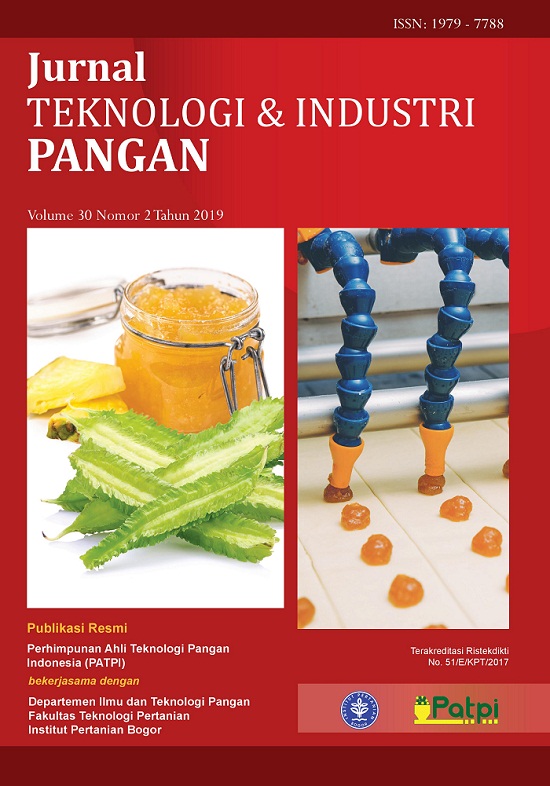PERBANDINGAN PROFIL SENSORI TEH HIJAU MENGGUNAKAN METODE ANALISIS DESKRIPSI KUANTITATIF DAN CATA (CHECK-ALL-THAT-APPLY)
Abstract
Tea is one of the most widely consumed beverages in the world. Different types of tea provide different sensory profiles. The present study aimed to evaluate sensory characteristics of green tea by analytical sensory evaluations through QDA (Quantitative Descriptive Analysis) and CATA (Check-All-That-Apply) methods. The sensory characteristics of green tea from three different countries (China, Thailand and Indonesia) were evaluated using QDA by trained panels and CATA by consumer panels. The QDA method revealed sensory characteristics of green tea, while CATA method presented information on consumer preferences towards the most desirable characteristics of green tea. The results showed that green tea has dominant characteristics of bitter taste, astringent aftertaste, green flavor, fermented flavor and dry aroma. Moreover, floral aroma and flavor in green tea have considerable influences on the panelist preferences. However, “nice to have” attribute was not found in the penalty analysis. The “must have” attribute in green tea was floral aroma, while the “must not have” attributes were burned aroma, burned flavor and dry aroma.
References
Ananingsih VK, Sharma A, Zhou W. 2013. Green tea catechins during food processing and sto-rage - A review on stability and detection. Food Res Int 50: 469-479. DOI: 10.1016/j.foodres.20 11.03.004.
Andriani F. 2010. Pemberian Ekstrak Teh Hijau Me-nurunkan Berat Badan, Lingkar Perut, dan Per-sentase Lemak Tubuh Pada Wanita Kelebihan Berat Badan yang Melakukan Latihan Fisik de-ngan Pola Makan Biasa. [Tesis]. Denpasar: Fakultas Kedokteran, Universitas udayana.
Ares G, Jaeger SR. 2013. Check-all-that-apply questions: Influence of attribute order on sen-sory product characterization. Food Qual Prefer 28: 141-153. DOI: 10.1016/j.foodqual.2012.08. 016.
Ares G, Barreio C, Deliza R, Gimenez A, Gambaro A. 2010. Application of a check-all-that-apply question to the development of chocolate milk desserts. J Sens Stud 25: 67-86. DOI: 10.1111/ j.1745-459X.2010.00290.x.
Ares G, Dauber C, Fernandez E, Gimenez A, Varela P. 2014. Penalty analysis based on CATA questions to identify drivers of liking and direc-tions for product reformulation. Food Qual Prefer 32: 65-76. DOI: 10.1016/j.foodqual.2013. 05.014.
Belusso AC, Nogueira BA, Breda LS, Mitterer-Dalto ML. 2016. Check-all-that-apply (CATA) as an instrument for development of fish products. Food Sci Technol (Campinas) 36: 275-281. DOI: 10.1590/1678-457X.0026.
Chueamchaitrakun P, Adawiyah DR, Prinyawiwat-kul, W. 2018. Understanding Indonesian peo-ple: Consumer acceptance and emotions study of green tea products from Thailand. Curr Appl Sci Technol 18: 37-44.
Dooley L, Lee YS, Meullenet JF. 2010. The applica-tion of check-all-that-apply (CATA) consumer profiling to ppreference mapping of vanilla ice cream and its comparison to classical external preference mapping. Food Qual Prefer 21: 395-401. DOI: 10.1016/j.foodqual.2009.10.002.
Giacalone D, Wender LP, Bredie, Frost MB. 2013. All-In-One Test (AI1): A rapid and easily appli-cable approach to consumer product testing. Food Qual Prefer 27: 108-119. DOI: 10.1016/j. foodqual.2012.09.011.
Graham HN. 2004. Green tea composition, con-sumption, and polyphenol chemistry. Prev Med 21: 334-350. DOI: 10.1016/0091-7435(92)9004 1-F.
Han ZX, Rana MM, Liu GF, Gao MJ, Li DX, Wu FG, Li XB, Wan XC, Wei S. 2016. Green tea flavour determinants and their changes over manufac-turing processes. Food Chem 212: 739-748. DOI: 10.1016/j.foodchem.2016.06.049.
Jaeger SR, Beresford MK, Paisle AG, Antúnez L, Vidal L, Cadena RS, Giménez A, Ares G. 2015. Check-all-that-apply (CATA) questions for sen-sory product characterization by consumers: In-vestigations into the number of terms used in CATA questions. Food Qual Prefer 42: 154-164. DOI: 10.1016/j.foodqual.2015.02.003.
Kim YK, Jombart L, Valentin D, Kim KO. 2013. A cross-cultural study using Napping®: Do Ko-rean and French consumers perceive various green tea products differently?. Food Res Int 53: 534-542. DOI: 10.1016/j.foodres.2013.05.0 15.
Lee J, Chambers DH. 2007. A lexicon for flavor des-criptive analysis of green tea. J Sens Stud 22: 256-267. DOI: 10.1111/j.1745-459X.2007.0010 5.x.
Lee J, Chambers DH. 2010. Flavors of green tea change little during storage. J Sens Stud 25: 512-520. DOI: 10.1111/j.1745-459X.2010.0028 3.x.
Lee J, Chambers DH. 2010. Descriptive Analysis and U.S. consumer acceptability of 6 green tea samples from China, Japan, and Korea. J Food Sci 75: 141-147. DOI: 10.1111/j.1750-3841.200 9.01503.x.
Lee J, Chambers E, Chambers DH, Chun SS, Oupa-dissakoon C, Johnson DE. 2010. Consumer acceptance for green tea by consumers in The United States, Korea and Thailand. J Sens Stud 25: 109-132. DOI: 10.1111/j.1745-459X.2010.0 0287.x.
Lee J, Delores H, Chambers DH, Chamber E, Adhikari K, Yoon Y. 2013. Volatile aroma com-pounds in various brewed green teas. Mole-cules 18: 10024-10041. DOI: 10.3390/molecu les180810024.
Limpawattana M, Shewfelt RL. 2010. Flavor lexicon for sensory descriptive profiling of different rice types. J Food Sci 75: 199-205. DOI: 10.1111/j. 1750-3841.2010.01577.x.
Meyners M, Castura JC, Carr BT. 2013. Existing and new approaches for the analysis of CATA data. Food Qual Prefer 30: 309-319. DOI: 10.1016/j. foodqual.2013.06.010.
Plaehn D. 2012. CATA penalty/reward. Food Qual Prefer 24: 141-152. DOI: 10.1016/j.foodqual.20 11.10.008.
Reinbach HC, Giacalone D, Ribeiro LM, Bredie WLP, Frost MB. 2014. Comparison of three sensory profiling methods based on consumer perception: CATA, CATA with intensity, and mapping. Food Qual Prefer 32: 160-166. DOI: 10.1016/j.foodqual.2013.02.004.
Rohdiana D, Firmansyah A, Setiawati A, Yunita N. 2012. Uji aktivitas antidiabetes ekstrak etanol teh hijau pada tikus putih. J Penelitian Teh dan Kina 15: 32-39.
Tannady H. 2015. Studi analisis kompetisi produk teh hijau dalam kemasan (studi kasus: joy tea). J Teknik Ilmu Komputer 5: 43-50.
Scharbert S, Hofmann T. 2005. Molecular definition of black tea taste by means of quantitative stu-dies, taste reconstitution, and omission experi-ments. J Agr Food Chem 53: 5377-5384. DOI: 10.1021/jf050294d.
Senanayake SPJ. 2013. Green tea extract: chemis-try, antioxidant properties, and food applicants - A review. J Funct Foods 5: 1529-1541. DOI: 10. 1016/j.jff.2013.08.011.
Stone H, Sidel JL. 2004. Sensory Evaluation Practices. 3rd ed. Elsevier Academic Press, San Diego (US).
Valentin D, Chollet S, Lelievre M, Abdi H. 2012. Quick and dirty but still pretty good: a review of new descriptive methods in food science. Int J Food Sci Technol 47: 1563-1578. DOI: 10.111 1/j.1365-2621.2012.03022.x.
Velayutham ABP, Sabitha KE, Shymaladevi CS. 2008. Effect of green tea extract on advanced glycation and cross-linking of tail tendon colla-gen in streptozotocin induced diabetic rats. Food Chem Toxicol 46: 280-285. DOI: 10.101 6/j.fct.2007.08.005.

